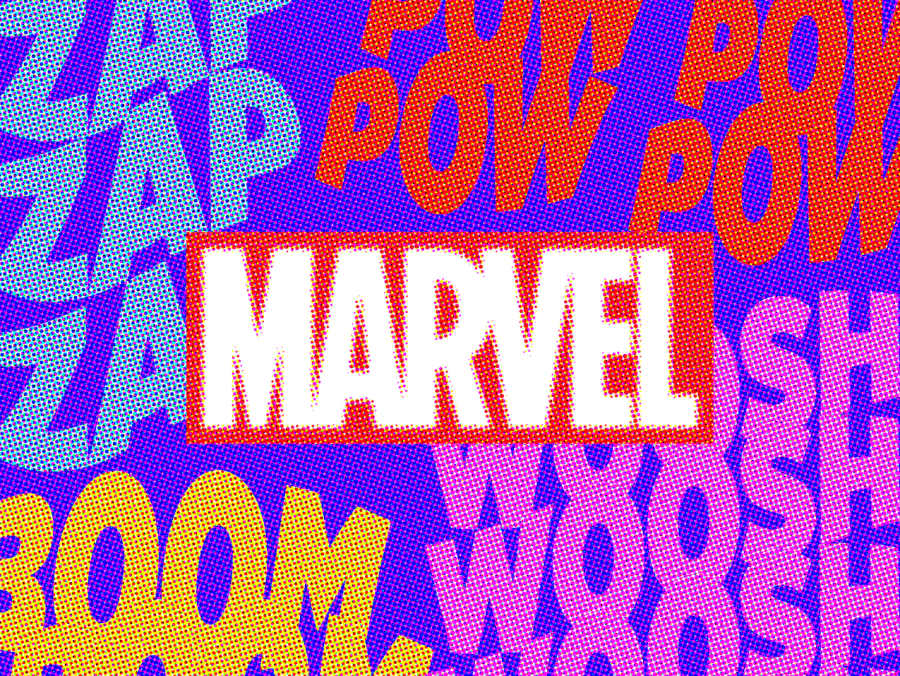A guide to the serpentine madness of the Marvel Cinematic Universe
Are you confused about what’s in the Marvel Cinematic Universe and what isn’t? So is (almost) everyone else. Let’s break it down.
The Marvel Cinematic Universe. (Staff Illustration by Susan Behrends Valenzuela)
May 4, 2022
Spoiler warning: This article may include spoilers for Marvel movies and series.
“The multiverse is a concept about which we know frighteningly little.” This line, said by Marvel’s Doctor Strange, was used heavily in marketing material for the 2021 hit “Spider-Man: No Way Home.” In my opinion, it should be the tagline for every non-comics property with the Marvel logo attached, particularly ahead of the release of the next Marvel movie, “Doctor Strange in the Multiverse of Madness.” Let me explain.
Throughout its comics, movies and shows, Marvel employs the concept of a multiverse. This is the idea of there being infinite universes with infinite possibilities.
This means that there’s a universe where I’m Spider-Man. There’s also a universe where I’m writing this very article, but about DC Comics instead of Marvel. The idea of a multiverse allows Marvel to use time travel, alternate versions of characters and multiversal events. It also is a convenient explanation for the countless legal disputes between Marvel and the studios that own the rights to its characters.
In the 1990s, Marvel struggled financially as the popularity of comics dwindled. Marvel sold the film rights of many well-liked characters to various Hollywood studios, presumably to both make money and increase the characters’ popularity.
With the newly acquired rights, the studios began releasing movies. These included 20th Century Fox’s “X-Men” in 2000 and Sony Pictures’ “Spider-Man” starring Tobey Maguire in 2002. In 2005, Marvel changed its name to Marvel Entertainment to reflect its new desire to turn properties it still owned into films.
Marvel still owned the film rights to the Avengers. When exploring what films they could begin producing independently, executives turned to two of the team’s founding members: Iron Man and the Hulk.
Universal Pictures had already produced a Hulk movie in 2003. When no sequel was able to be produced, however, Universal agreed to return the film rights to Marvel in 2006. Meanwhile, Marvel was working on another project — in May of 2008, “Iron Man” was released to overwhelming success.
Directed by Jon Favreau and starring Robert Downey Jr., “Iron Man” began the Marvel Cinematic Universe. It not only was the first movie of an incredibly successful franchise, but it also set the tone for future MCU projects. Characters would stay grounded in reality despite absurd surroundings, relationships would drive stories without being the focus and quips would keep stories fun. The film also included a post-credits scene to tease viewers about future projects. “Iron Man” was just the beginning.
After the 2008 releases of “Iron Man” and “The Incredible Hulk,” the Walt Disney Company purchased Marvel Entertainment for $4.3 billion. Under Disney, the MCU would grow. Eventually, “The Avengers” premiered in 2012, combining aspects from all previous MCU movies into a comic nerd’s dream.
Disney’s acquisition of Marvel created a fine line between the MCU and non-Disney Marvel properties. In short, any Marvel movie released prior to “Iron Man” is not a part of the MCU, along with almost any future non-Disney Marvel movie. This includes Sony’s 2012 Spider-Man reboot “The Amazing Spider-Man” starring Andrew Garfield and Fox’s 2015 “Fantastic Four.”
For a long time, these movies were disconnected from the MCU. That would eventually change. Surprisingly, this wouldn’t come with Disney’s 2019 acquisition of Fox, but rather with Spider-Man.
In 2016, Marvel released “Captain America: Civil War” and brought Spider-Man into the MCU. This Spider-Man wasn’t played by Maguire or Garfield, but instead by Tom Holland. The third cinematic representation of the character was the result of a complex agreement between Marvel and Sony. Spider-Man could appear in the MCU — even in his own movie, 2017’s “Spider-Man: Homecoming” — as long as Sony was able to release the Marvel-produced Spider-Man movies.
In 2021, “No Way Home” premiered, changing the relationship between Spider-Man and the MCU franchise. Maguire, Garfield and villains from their prior films appeared in the 2021 movie. However, their franchises are still not canonical to the MCU. Rather, they are canonical to the Marvel multiverse. Maguire and Garfield are variants of Spider-Man from other universes — universes they eventually return to. Their movies do not take place in the MCU, but instead in alternate universes.
The concept of variants was first introduced into the MCU in the Disney+ television series “Loki” — which brings us to Marvel’s confusing live-action television shows.
Shows from before Disney’s acquisition of Marvel are not canon to the MCU. When 2013’s “Agents of S.H.I.E.L.D” premiered, many interpreted it as canon along with standalone shows like “Agent Carter” and shows connected to the Netflix series “The Defenders” like “Daredevil.” In 2019, however, President of Marvel Studios Kevin Feige declared all Marvel TV shows as not part of MCU canon.
Marvel’s first new show, “WandaVision,” was soon premiering on Disney+ and it would be more convenient to have only Disney+ releases be canon. According to rumors, executive disputes also may have contributed to the decision.
“WandaVision” released in 2021 and became an instant favorite. The story of a woman — albeit one with universe-bending powers — coping with grief through the familiar medium of classic sitcoms resonated with audiences. This was followed up with “The Falcon and the Winter Soldier” and “Loki,” the latter of which introduced the concept of the multiverse to the MCU. This introduction of the multiverse allowed for shows like “What If…?” — the only animated piece of MCU canon — and movies like “No Way Home” and “Multiverse of Madness.”
In December 2021, change would again come to Marvel’s shows. “No Way Home” and the Disney+ show “Hawkeye” both included characters from “Daredevil.” Unlike Maguire and Garfield’s Spider-Man variants, Charlie Cox’s Daredevil and Vincent D’Onofrio’s Kingpin are the same ones that were seen in the Netflix series.
A couple months later, the Marvel shows on Netflix were moved to Disney+. With these developments, the Netflix shows were once again canon to the MCU. While this extended to “Agent Carter,” AOS is still believed by many to not be canon, though it could take place in a different parallel universe.
With Disney now owning the rights for characters previously owned by Fox, MCU movies starring the Fantastic Four or the X-Men are possible. A Fantastic Four movie is in the works, but information about it is sparse.
“Doctor Strange in the Multiverse of Madness” will premiere on May 6 and is rumored to introduce mutants — and therefore X-Men — to the MCU. Nothing has been confirmed, though, and we’ll just have to watch the movie to find out.
Contact Gillian Blum at [email protected].

























































































































































